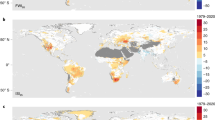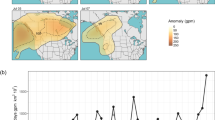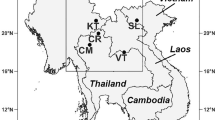Abstract
There is evidence that the area burned by wildland fire has increased in certain regions of Canada in recent decades. One cause for this increase is changes in the mid-tropospheric circulation at 500 hPa over northern North America. This study examines the physical links between anomalous mid-tropospheric circulation over various regions of Canada and wildland fire severity. Analysis of monthly and seasonal burned areas for the period 1953 to 1995 reveals a bimodal distribution with distinct low and extreme high burned area years. The high/low burned area years coincide with positive/negative 500 hPa height anomalies over north-western, western, west-central and east-central Canada. Total area burned and the 500 hPa height anomaly data are analysed for statistical relationships using the Spearman rank correlation non-parametric measure. Results for the May to August fire season indicate statistically significant correlations between regional total area burned and clusters of anomalous 500 hPa geopotential height values immediately over and immediately upstream of the affected region. For the north-western and west-central regions, significantly correlated clusters are also found in the central Pacific, providing evidence of the influence of a teleconnection structure on the summer climate of western and north-western North America. Two sample comparison tests show statistically significant differences in both the means and variances of the fire data populations during negative and positive phases of mid-tropospheric flow and the means of the height anomaly populations during extremely high and extremely low area-burned seasons. Increases in regional total area burned are related to increases in mean 500 hPa heights, taken from the significantly correlated clusters of height values, between two successive periods 1953–1974 and 1975–1995. For Canada as a whole, the five lowest area-burned seasons all occurred during the early period, while the five highest seasons occurred during the later period. The difference in the geopotential height fields between the two periods identifies an increase in 500 hPa heights over most of Canada with an amplification of the western Canada ridge and an eastward shifted Canadian Polar Trough (CPT).
Access this chapter
Tax calculation will be finalised at checkout
Purchases are for personal use only
Preview
Unable to display preview. Download preview PDF.
Similar content being viewed by others
References
Alexander, M.E., Janz, B., Quintillo, D., 1983: Analysis of extreme wildfire behaviour in east-central Alberta: a case study. In Proceedings of the 7th Conference on Fire and Applied Meteorology, 25–28 April 1983, Fort Collins, Colorado. American Meteorological Society, Boston. Mass., 38–46.
Barnston, A.G., Livezey, R.E., 1987: Classifications, seasonality and persistence of low frequency atmospheric circulation patterns. Monthly Weather Review, 115, 1083–1126.
Bonsal B.R., Chakravarti, A.K., Lawford, R.G., 1993: Teleconnections between north Pacific SST anomalies and growing season extended dry spells on the Canadian Prairies. International journal of Climatology, 13, 865–878.
Caya D., Laprise, R., Giguere, M., Bergeron, G., Blanchet, J.P., Stocks, B.J., Boer, G.J., McFarlane, N.A., 1995: Description of the Canadian Regional Climate Model. In Price, D.T., Wisniewski, J., (eds.), Boreal Forests and Global Change, Kluwer Academic Publishers, Dordrecht, 477–482.
Finklin, M.D., 1973: Meteorological factors in the Sundance fire run. USD A Forestry Service General Technical Report INT-6.
Flannigan, M.D., Harrington, J.B., 1986: Synoptic weather conditions during the Porter Lake experimental fire project. Climatological Bulletin, 20, 19–40.
Flannigan, M.D., Harrington, J.B., 1988: A study of the relation of meteorological variables to monthly provincial area burned by wildfire in Canada (1953–80). Journal of Applied Meteorology 27,441–452.
Graham, N.E., 1994: Decadal-scale climate variability in the tropical and North Pacific during the 1970s and 1980s: observations and model results. Climate Dynamics, 10, 135–162.
Harrington, J.B., 1982: A statistical study of area burned by wildfire in Canada 1953–1980. Environment Canada, Canadian Forestry Service, Petawawa National Forest Institute Information Report PI-X-16, 32p.
Henderson, K.G., Robinson, P.J., 1994: Relationships between the Pacific/North America teleconnection patterns and precipitation events in the south-eastern USA. International Journal of Climatology, 14, 307–232.
Horel, J.D., 1981: A rotated principal component analysis of the interannual variability of the Northern Hemisphere 500 mb height field. Monthly Weather Review, 109, 2080–2092.
IPCC 1995: Climate change 1995: impacts, adaptations and mitigation of climate change: scientific-technical analysis. Watson, R.T., Zinyowera, M.C., R.H. Moss, R.H., (eds), Cambridge University Press, Cambridge, UK., 878p.
Janz, B., Nimchuk, N., 1985: The 500 mb chart - a useful fire management tool. In Proc. of the 8th Conf on Fire and Appl. Met., 29 April - 2 May 1985, Detroit, Michigan. Society of American Foresters, Washington, D.C., 233–238.
Jenne, R., 1975: Data Sets for Meteorological Research, NCAR-TN/JA111, 194 p. [Available from Order Department, US Department of Commerce, National Technical Information Service, Springfield Virginia, US 22161].
Johnson, E.A., Wowchuk, D.R., 1993: Wildfires in the southern Canadian Rocky Mountains and their relationship to mid-tropospheric anomalies. Canadian Journal of Forest Research, 23, 1213–1222.
Knox, J.L., Higuchi, K., Shabbar, A., Sargent, N.E., 1988: Secular variations of the Northern Hemisphere 50 kPa geopotential height. Journal of Climatology, 5, 500–511.
Knox, J.L., Lawford, R.G., 1990: The relationship between Canadian prairie dry and wet months and circulation anomalies in the mid-troposphere. Atmosphere-Ocean, 28, 189–215.
Knox, J.L., 1991: Northern Hemisphere Circulation. Internal Report, Canadian Climate Centre, Downsview, Ontario, 29pp.
Kurz, W.A., Apps, M.J., Stocks, B.J., Volney, W. JA., 1995: Global climate change: disturbance regimes and biospheric feedbacks of temperate and boreal forests. In Woodwell, G.M., Mackenzie, F.T., eds. Biotic feedbacks in the global climatic system. New York: Oxford University Press, 119–13.
Leathers, D.J., Yarnal, B., Palecki, M.A., 1991: The pacific/North American teleconnection pattern and United States climate. Part I: Regional temperature and precipitation associations. Journal of Climatology, 4, 517–528.
Mantua, N.J., Hare, S.R., Zhang, Y., Wallace, J.M., Francis, R.C., 1997: A Pacific interdecadal climate oscillation with impacts on salmon production. Bulletin of the American Meteorological Society, 78, 6, 1069–1079.
Namias, J., 1955: Some meteorological aspects of drought with special reference to the summers of 1952–54 over the United States. Monthly Weather Review, 83, 199–205.
Namias, J., 1982: Anatomy of Great Plains protracted heat waves (especially the 1980 U.S. summer drought). Monthly Weather Review, 110, 824–838.
Newark, M.J., 1975: The relationship between forest fire occurrence and 500 mb longwave ridging. Atmosphere, 13, 1,26–33.
Schroeder, M.J., Glovinsky, M., Hendricks, V.H., et al., 1964: Synoptic weather types associated with critical fire weather. USDA Forest Service. Pacific Southwest Forest and Range Experimental Station, Berkeley, California.
Shabbar, A., Higuchi, K., Skinner, W., Knox, J.L., 1997: The association between the BWA index and winter surface temperature variability over eastern Canada and west Greenland. International journal of Climatology, 17, 1195–1210.
Simard, A.J., 1997: National workshop on wildland fire activity in Canada. Science Branch, Canadian Forestry Service, Natural Resources Canada, 38p.
Skinner, W.R., Gullett, D.W., 1993: Trends of daily maximum and minimum temperature in Canada during the past century. Climate Bulletin, 27, 2, 543–557.
Skinner, W.R., Stocks, B.J., Martell, D.L., Bonsai, B., and Shabbar, A.. 1998: The association between circulation anomalies in the mid-troposphere and area burned by wildland fire in Canada. Theoretical and Applied Climatology, in press.
Stocks, B.J., Lee, B.S., Martell, D.S., 1996: Some potential carbon budget implications of fire management in the boreal forest, p. 89–96 in Forest Ecosystems, Forest Management and the Global Carbon Cycle. Apps, M.J., Price, D.T., (eds.), NATO ASI Series, Subseries 1, Global Environmental Change. Vol.40, Springer-Verlag, Berlin, Germany.
Stocks, B.J., Fosberg, M.A., Lynham, T.J., Mearns, L., Wotton, B.M., Yang, Q., Jin, J-Z., Lawrence, K., Hartley, G.R., Mason, J.A., McKenney, D.W., 1998: Climate change and forest fire potential in Russian and Canadian boreal forests. Climate Change 38, 1–13.
Street, R.B., 1985: Drought and synoptic fire climatology of the boreal forest region of the Canadian prairie provinces. In Proc. of the 8th Conf. on Fire and Appl. Met., 29 April - 2
May 1985, Detroit, Michigan. Society of American Foresters, Washington, D.C., 108–112.
Street, R.B., Birch, E.C., 1986: Synoptic fire climatology of the Lake Athabasca - Great Slave Lake area, 1977–1982. Climate Bulletin, 20, 3–18.
Trenberth, K.E., Branstator, G.W., Arkin, P.A., 1988: Origins of the 1988 North American drought. Science, 242, 1640–1645.
Trenberth, K.E., 1990: Recent observed interdecadal climate changes in the Northern Hemisphere. Bulletin of the American Meteorological Society, 71, 7, 988–993.
Wallace, J.M., Gutzler, D.S., 1981: Teleconnections in the geopotential field during the Northern Hemisphere winter. Monthly Weather Review, 109, 784–812.
Yarnal, B., Diaz, H.F., 1986: Relationships between extremes of the Southern Oscillation and the winter climate of the Anglo-American Pacific coast. Journal of Climatology, 6, 197–219.
Author information
Authors and Affiliations
Editor information
Editors and Affiliations
Rights and permissions
Copyright information
© 2000 Kluwer Academic Publishers
About this chapter
Cite this chapter
Skinner, W.R., Stocks, B.J., Martell, D.L., Bonsal, B., Shabbar, A. (2000). The Relationship Between Area Burned by Wildland Fire in Canada and Circulation Anomalies in the Mid-Troposphere. In: Innes, J.L., Beniston, M., Verstraete, M.M. (eds) Biomass Burning and Its Inter-Relationships with the Climate System. Advances in Global Change Research, vol 3. Springer, Dordrecht. https://doi.org/10.1007/0-306-47959-1_7
Download citation
DOI: https://doi.org/10.1007/0-306-47959-1_7
Publisher Name: Springer, Dordrecht
Print ISBN: 978-90-481-5375-6
Online ISBN: 978-0-306-47959-5
eBook Packages: Springer Book Archive




